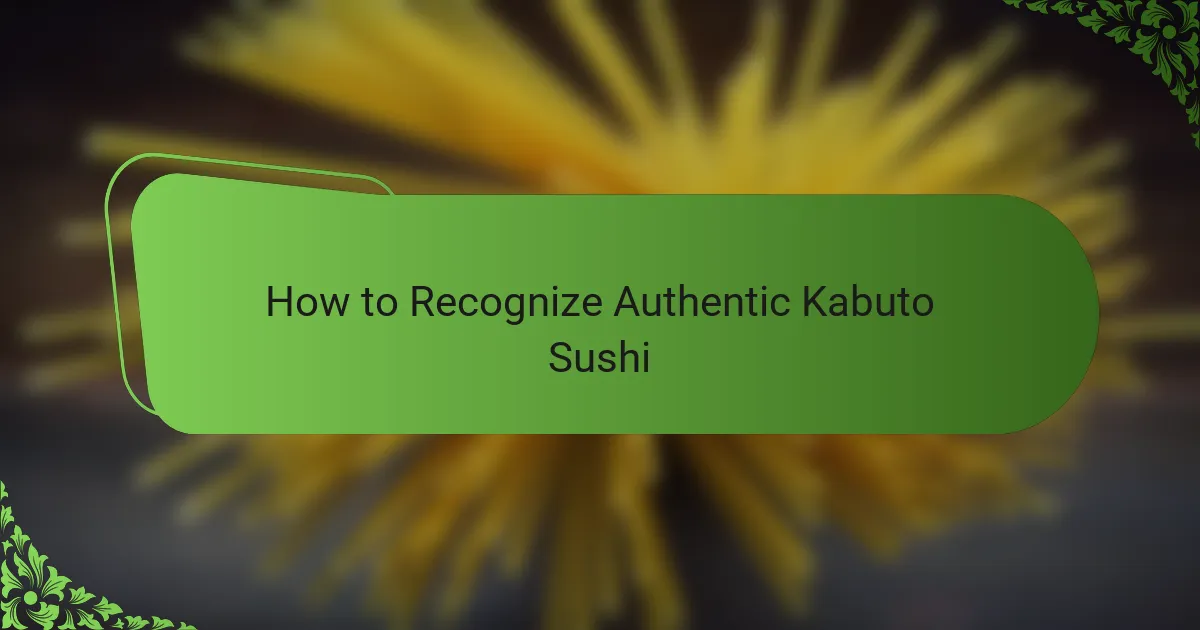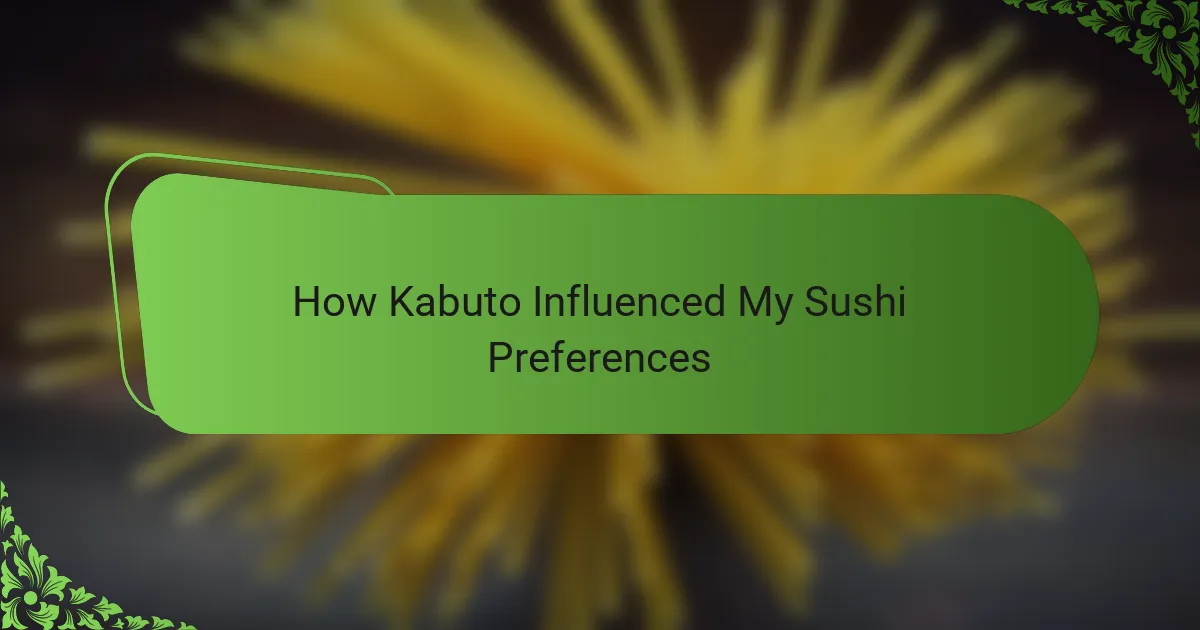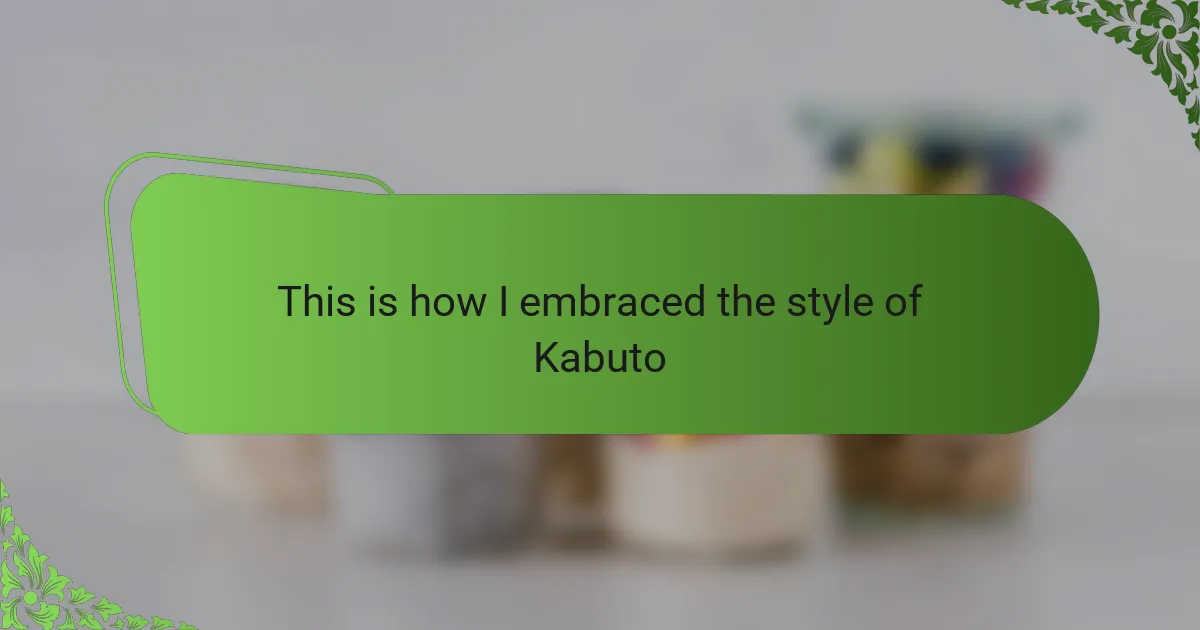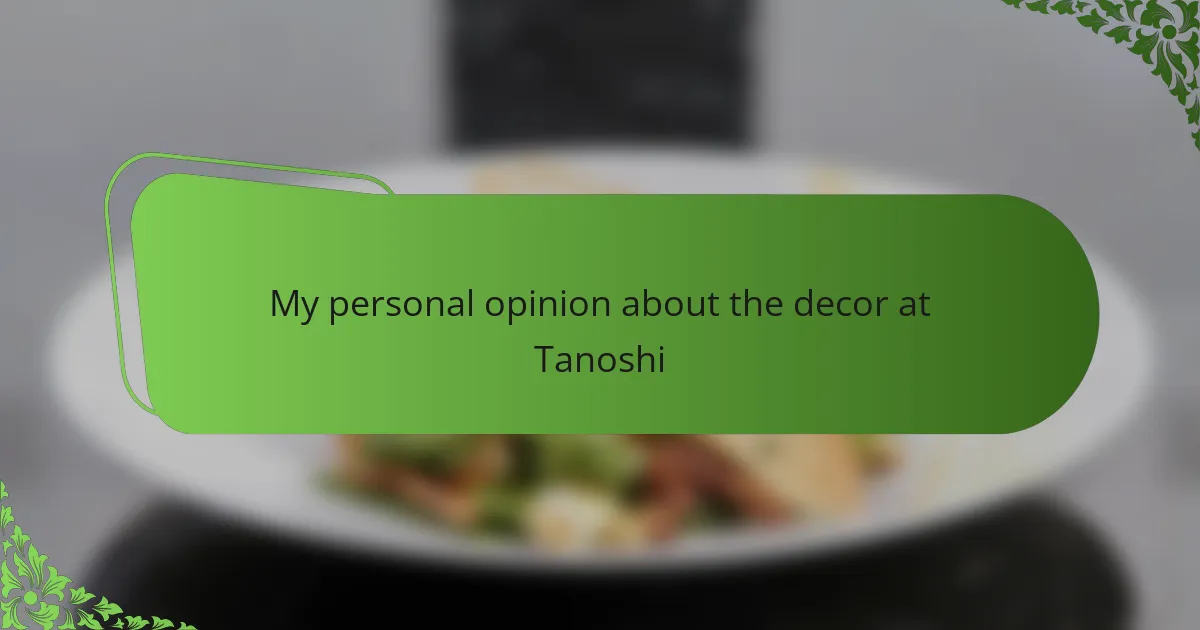Key takeaways
- Kabuto sushi emphasizes simplicity and high-quality ingredients, allowing natural flavors to shine without unnecessary embellishments.
- The chefs practice patience and precision, treating each piece as a crafted artwork, which enhances the overall dining experience.
- True appreciation of Kabuto sushi involves savoring each bite, celebrating the texture and freshness of the ingredients while avoiding overpowering flavors.
- The experience of Kabuto has transformed personal sushi preferences to prioritize tradition, quality, and a mindful approach to eating.

What is Kabuto Sushi Style
Kabuto sushi style is all about honoring tradition with an unwavering commitment to quality and simplicity. When I first encountered it, I was struck by how each piece was a tiny masterpiece—carefully crafted, yet unpretentious. Have you ever wondered what makes sushi feel so authentic? For me, Kabuto’s approach answers that perfectly.
What sets Kabuto apart is its focus on sourcing the freshest, highest-grade ingredients and presenting them without unnecessary embellishments. It’s a style that demands respect for every element on the plate—from the rice to the fish—inviting you to savor each flavor thoughtfully. I remember feeling a deep appreciation for how this restraint turned every bite into a moment of mindfulness.
Also, Kabuto doesn’t rush the process. The chefs take their time, often preparing each piece individually at the counter. Watching that dedication unfold in front of me made the experience feel almost sacred. Isn’t it amazing how when tradition and patience come together, they create something truly memorable?

Key Features of Kabuto Sushi
One feature of Kabuto sushi that really caught my attention is the emphasis on simplicity. Each piece is stripped down to its purest form, allowing the natural flavors to truly shine. Have you ever tasted sushi that felt overloaded? With Kabuto, it’s the opposite—every ingredient earns its place, making each bite incredibly balanced.
The texture of the rice in Kabuto sushi stood out to me as well. It’s neither too sticky nor too loose, holding just right to support the delicate fish without overpowering it. I found that this careful handling of rice heightened the overall experience, almost like the foundation of a well-built house that you don’t notice until it’s done imperfectly.
Another aspect that defines Kabuto is the chef’s craftsmanship. Watching the chefs at work, with such precision and calm, felt almost meditative. This patient, hands-on approach made me realize how much respect and care goes into every piece—a daily ritual that transforms food into art. Doesn’t that make you appreciate sushi on a whole new level?

How to Recognize Authentic Kabuto Sushi
When I first tried to recognize authentic Kabuto sushi, I realized it wasn’t just about the look—it was about how it made me feel. The fish had this unmistakable freshness that almost melted on my tongue, and the rice was perfectly seasoned and balanced. Have you ever noticed that some sushi feels like it’s been rushed, while Kabuto’s creations invite you to slow down and savor each bite?
What really helped me identify genuine Kabuto sushi was the obvious care in its presentation. Nothing seemed overdone or flashy; instead, each piece had a quiet elegance that spoke volumes about the chef’s respect for tradition. Watching the chefs work at the counter, I noticed the deliberate pace and focus—they treated sushi-making like a craft, not a chore. Doesn’t that changed how you see your food when you witness that kind of dedication?
Texture was another subtle clue for me. The rice held its shape just right—not too tight, not too loose—supporting the fish gently yet firmly. That balance reminded me of a well-rehearsed dance, where every step matters. So next time you’re at a sushi bar, take a moment to feel the difference yourself—authentic Kabuto sushi isn’t just tasted; it’s experienced.

Personal Experience with Kabuto Sushi
Sitting at the counter of a small, authentic sushi bar, I found myself completely absorbed in the Kabuto experience. The quiet focus of the chef, slicing fish with deliberate care, made me realize how much I’d taken sushi for granted before. Have you ever felt that sudden respect for a craft you thought you knew well? That moment stuck with me.
The first bite was surprisingly profound. I remember closing my eyes, letting the subtle flavors unfold slowly, as if the sushi were telling me a story. It wasn’t just food—it was tradition, patience, and passion on a tiny rice bed. Doesn’t that kind of mindful eating transform a simple meal into something memorable?
Over time, I started embracing Kabuto style not just as a way to enjoy sushi, but as a small lesson in simplicity and respect. I tried to savor things more, to notice the details others might overlook. Isn’t it amazing when food teaches you something deeper about slowing down and appreciating quality?

Tips for Enjoying Kabuto Sushi
To really enjoy Kabuto sushi, I found that patience is key. Instead of rushing through each piece, I learned to take a moment to appreciate the subtle balance of flavors—a gentle nod to the chef’s dedication. Have you ever caught yourself eating sushi too quickly and missing the quiet complexity within?
Another tip I swear by is sitting at the counter whenever possible. Watching the chef craft each piece slowly and meticulously adds a whole new dimension to the experience. It’s almost like being part of a private performance where every motion matters—I never wanted that moment to end.
Finally, I recommend embracing simplicity with your palate. Kabuto sushi is about letting the quality of each ingredient shine, so I try to avoid overpowering sauces or excessive wasabi. Isn’t it refreshing when food speaks for itself without needing extra fuss?

Best Dishes at Kabuto Restaurant
One dish that truly captured my heart at Kabuto was their toro nigiri. The melt-in-your-mouth fattiness combined with the subtle sweetness of the perfectly seasoned rice made me pause and savor every bite. Have you ever experienced a flavor so pure it made you stop and just be present? That’s exactly how this toro made me feel.
I also can’t forget the amaebi, or sweet shrimp, which was served incredibly fresh. The delicate texture and natural sweetness were enhanced simply with a touch of soy, proving that sometimes less really is more. Watching the chef place each shrimp with such care reminded me of the importance of honoring the ingredient’s natural qualities.
Lastly, their miso soup stood out to me—not the usual quick broth, but something deeply comforting, brimming with umami and small pieces of fresh tofu and seaweed. It felt like a warm embrace after each sushi course, tying together the meal in a way that made me appreciate the thought behind every dish. Isn’t it interesting how even the simplest sides can elevate an entire dining experience?

How Kabuto Influenced My Sushi Preferences
Kabuto shaped my sushi preferences by teaching me to truly value simplicity. Before, I often chased bold flavors or elaborate rolls, but after savoring Kabuto’s restrained style, I realized that sometimes less really is more. Have you ever noticed how a minimalist approach can reveal nuances you’d otherwise miss?
What struck me most was how Kabuto made me slow down and appreciate the texture and freshness of each ingredient. That deliberate pace changed my expectations—I began craving sushi that felt crafted with intention rather than convenience. Isn’t it amazing how a change in approach can deepen your appreciation for something familiar?
Over time, I started seeking out sushi that honors tradition and quality as Kabuto does. This shift taught me that sushi isn’t just about hunger; it’s about respect for the process and the ingredients. Honestly, that awareness has transformed each meal into a small ceremony rather than just a quick bite.



